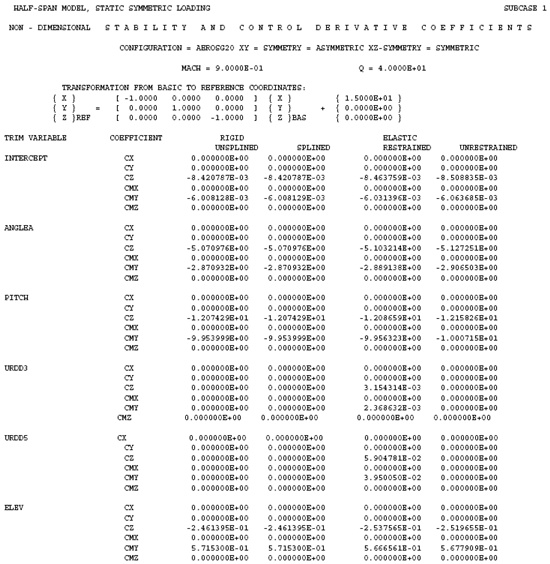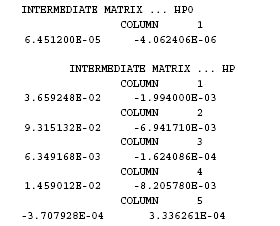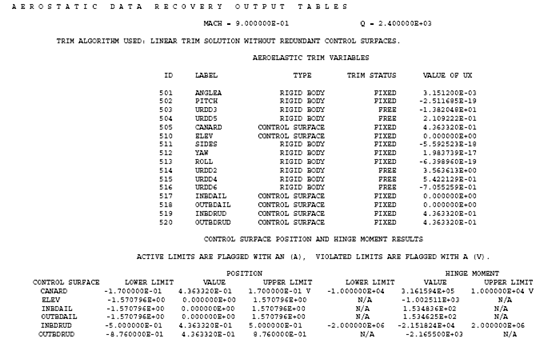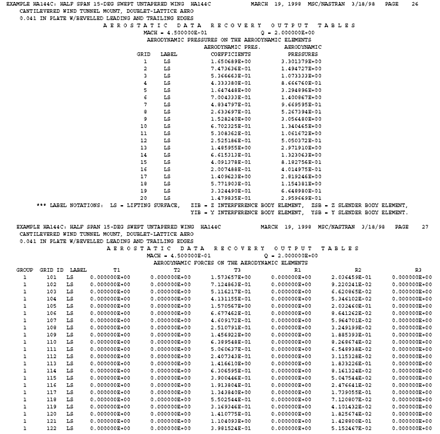XXXXXXXXXXXXXXXXXXXXXXXXXXXXXXXXXXXXXXXXXXXXXXXXXXXXXXXXXXXXXXXXXXXXXXXXXXXXXXXXXXXXXXXXXXXXXXXXXXXXXXXXXXXXXXXXXXXXXXXXXXXXXXXXXXXXXXXXXXXXXXXXXXXXXXXX''"> Printed Output
The primary goal of FlightLoads is to bring visibility to the process of the development of flight loads. The main body of this manual has emphasized the Graphical User Interface of FlightLoads, but there are also important pieces of information that are produced by the system that do not have a visual component. Instead, they are presented as tables within the printed.f06 output that is produced as part of the MSC.Nastran run. This section documents this output and has been assembled by adapting documentation that is contained in the MSC Nastran User’s Guide for Aeroelasticity, the Release Guide for Version 70.5 of MSC.Nastran and new material for this document.
Stability Derivatives and Hinge Moment Coefficients
Stability derivatives are invaluable for characterizing the performance and handling of an air vehicle. They allow for communication with Flight Controls engineers in the language they understand. Within the context of FlightLoads, they are also useful for checking the reasonableness of the results and the quality of the splines.
Aeroelastic Solutions has derived the stability derivative calculations in pieces. Hinge moment coefficients are a special type of stability derivative that requires special handling and display. This subsection brings this information together and provides an illustration of how the data appear in the printed output.
Seven input matrices provide dimensional r-set force increment data for the computation of rigid, elastic restrained and elastic unrestrained intercepts, stability derivatives and hinge moments. These data are;
• KRZX - restrained dimensional coefficients
• Z1ZX - unrestrained dimensional coefficients
• RSTAB - rigid dimensional coefficient from aero mesh
• KSAZX - rigid dimensional coefficient from structural mesh
• RHMC - F rigid dimensional hinge moments
• ERHM - elastic, restrained dimensional hinge moments
• EUHM - elastic, unrestrained dimensional hinge moments
Note that the hinge moment data are a single value (hinge moment) for each control surface while the others are single values for each support point for each control surface/intercept.
Each of these matrices can be related to the unit solutions approach. For example:
(E‑61)

(E‑62)

(E‑63)

(E‑64)

Hinge moment derivatives: These can also be computed easily from the unit solutions’ forces once the

are available from each of the unit solutions using intermediate data from the application of
(E‑57). MSC Nastran computes a HMKT matrix that integrates the hinge moment for each control surface using a k-set sized force distribution as input. Therefore, all the (dimensional) control surface hinge moment increments are immediately available as:
(E‑65)

(E‑66)

(E‑67)

(E‑68)

(E‑69)

Figure E‑1 provides typical output for stability derivatives. Four sets of stability derivatives computed about the origin of the aerodynamic reference coordinate system and are generated for the system for each flight condition in that coordinate system:
1. Rigid unsplined
2. Rigid splined
3. Elastic restrained at the SUPORTed degrees of freedom
4. Elastic unrestrained
Before the stability derivatives are tabulated, the transformation from the basic to the reference coordinates is shown. This transformation provides a check on the input of the aerodynamic reference coordinate system for the stability derivatives. The stability derivatives for the rigid and elastic vehicle are shown next. The rigid derivatives are those that are obtained while neglecting elastic deformation of the vehicle. These derivatives are presented in two ways: unsplined and splined coefficients which provide checks on the splining and structural boundary conditions (e.g., single point constraints reacting forces through any actuator can cause apparent load loss). The unsplined coefficients are based on all the boxes in the aerodynamic model and are independent of the spline. usually, the two sets of coefficients are nearly identical unless there is an error in the spline input, such as not including all of the boxes. However, there may be situations where some boxes intentionally may not be connected to the spline, as in the case when no motion of certain boxes is desired. This latter case can be avoided by mapping the forces of those non-moving boxes using a FORCE spline.

Figure E‑1 Stability Derivative Example
Non-dimensional hinge moment coefficient data are output in the format shown in
Figure E‑2. Each aerodynamic extra point produces its own row of hinge moment coefficients. The hinge moments are computed directly from the aerodynamic model, rather than from the structural model that is used for the splined stability derivative data. For this reason, there is no comparison of the splined and unsplined hinge moment coefficients as there is for the stability derivatives. There are values for the restrained and unrestrained coefficients.
.

Figure E‑2 Hinge Moment Coefficients Example
Note also that since the integration is performed on the aerodynamic mesh, the inertial moment is not included in the hinge moment. However, the aeroelastic load induced by the deformations caused by the inertial forces is included.
HP and HP0 Matrices
The HP and HP0 matrices are the r-set displacements due to the restrained unit trim parameter forces and the aerodynamic intercept force, respectively. The displacements that correspond to these terms are found in
(E‑44) and
(E‑45), so that
(E‑70)

These terms are printed using a MSC Nastran matrix utility and appear in the output as shown in
Figure E‑3.
Figure E‑3 HP0 and HP Matrix Example
Trim Results and Control Surface Limits
The solution for the trim variables in FlightLoads is almost always carried out by solving the simultaneous equations given by
(E‑28). MSC.Nastran can also obtain a solution when there are redundant control surfaces and one or more of these control surfaces may be limited to a user specified value of the control surface deflection or hinge moment. These nonlinear solutions are a recent innovation and not considered part of the standard FlightLoads capability. However, the reporting of the trim analysis method in the printed output could make reference to these alternative methods, so they are touched upon here.
There are five possible trim solutions that can occur and these are given in
Figure E‑4.
Figure E‑4 Trim Algorithm Selection
Figure E‑5 shows an example of the trim output, including the trim selection method. There are two tables in
Figure E‑5. The first gives the aeroelastic trim variables by ID and name and value. The table also lists the variable type “RIGID BODY” or “CONTROL SURFACE” and the trim status. There are four types of trim status: FREE, FIXED, SCHEDULED and LINKED and they indicate that the variable value was free to vary, fixed by the user, scheduled using the CSSCHD entry or linked. (Scheduling has not been discussed in this guide, but is documented in the
MSC Nastran V70.5 Release Guide.)
The second table provides control surface limit results. Each control surface has an upper and lower limit on its position and hinge moment value. The actual values are also listed and flags are provided to quickly identify any active limit (i.e., a response that is not violated but is within 3% of the prescribed limit marked with an (A)) while any violated constraint (i.e., a response that exceeds its limit by more than 0.3% marked with a (V)). Units of the output are radians for the positions and physically consistent units (e.g., newton-meters) for the hinge moments.
Figure E‑5 Trim Output and Control Surface Limits
Pressure and Forces on the Aerodynamic Elements
As a final example of printed output,
Figure E‑6 depicts pressure and forces that are imposed on the aerodynamic model at trim. The pressures are printed in both dimensional and non-dimensional form and are listed in order of the aerodynamic elements starting from one.
The force output is printed in the format of standard OLOAD output in MSC.Nastran. Six degrees of freedom are printed for each aerodynamic grid even though one or more terms is zero for each grid.
Figure E‑6 Aerodynamic Pressure and Force Output Example




